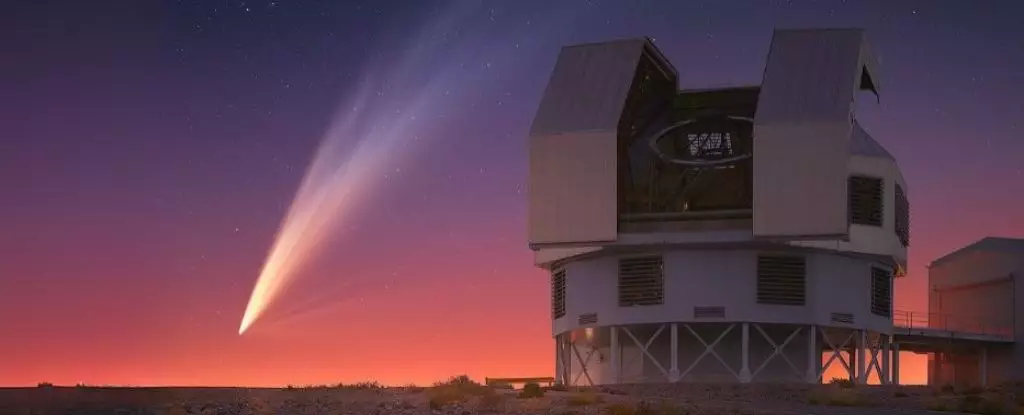Comets have long captivated the human imagination, their unpredictable nature resembling the ebb and flow of our own aspirations. Every time a new comet is identified, it invokes a flurry of excitement and hopeful expectations among astronomers and enthusiasts alike. Yet, as we delve into the world of Comet C/2024 G3 ATLAS, we are reminded of the duality of these celestial wanderers: while they can dazzle and inspire, they can also leave us longing for more. Discovered on April 25, 2024, by the Asteroid Terrestrial-impact Last Alert System (ATLAS), G3 ATLAS presented itself as a beacon of celestial wonder, promising an impressive display near its perihelion in January 2025. However, the allure of such a promise is often tempered by the lurking specter of uncertainty that shadows these cosmic entities.
The history of cometary observations is fraught with examples that illustrate the fickleness of these celestial bodies. Take, for instance, the infamous Comet C/2012 S1 ISON, which drew immense public interest only to disintegrate spectacularly just before it could enchant skywatchers during Thanksgiving in 2013. Conversely, Comet W3 Lovejoy defied expectations, emerging from a perilous proximity to the Sun and continuing to shine brightly even after its close encounter. Such stories serve as reminders that predicting the behavior of comets is equal parts science and art, steeped in a rich tapestry of successes and disappointments.
As G3 ATLAS approached its perihelion—an event where it drew within 14 million kilometers of the Sun on January 13, 2025—the anticipation grew. The performance of the comet measured up to expectations initially, reaching a luminosity of -3.8 magnitude, making it one of the brightest comets witnessed since P1 McNaught in 2007. The renowned LASCO C3 imager onboard the Solar and Heliospheric Observatory (SOHO) caught this celestial spectacle, and soon images from enthusiasts around the globe flowed in. Observers hoped for a long-lasting display that would allow them to witness its magnificence in night skies.
Yet, much like a soliloquy veering into an unexpected twist, the trajectory of G3 ATLAS soon took a disheartening turn. For many stargazers in the northern hemisphere, accessibility to the comet proved elusive. Its visibility was fleeting, primarily shining down south during its prime appearance. This phenomenon echoes an oft-observed trend where prominent comets seem to harbor a preference for southern skies, leaving northern spectators yearning for a more intimate view of this wandering star.
As January rolled on, reports began surfacing about G3 ATLAS exhibiting signs of hardship. Around January 18, the comet’s nucleus appeared to suffer, transforming G3 ATLAS into a ‘headless comet’—a term used in the astronomical community to describe a comet losing its nucleus while its tail continues to shine. This unnatural decline marked a stark contrast to the anticipation of a vibrant tail, yet the tail provided fleeting beauty even as the comet itself waned.
Another striking aspect of comets is their tails, which under the influence of the solar wind, appear to lead instead of follow. G3 ATLAS’s tail manifested in a remarkably striped appearance in its final days, a dance of particles that captivated onlookers. Visibility dwindled, but the comet remained a poignant reminder of the transience of beauty in the cosmos.
With estimates suggesting that G3 ATLAS is bound to a staggering 160,000-year inbound orbit and potentially a 600,000-year outbound journey, the comet’s story did not end with its transient appearance. The implications of its eventual return—should fragments survive the harrowing journey through the solar system—spark endless fascination. Would future observers be graced with a repeat of the fleeting splendor that stirred the imaginations of many during its brief vibrant display?
As we engage with the unpredictable nature of comets—like G3 ATLAS—each encounter is marked by anticipation, disappointment, and ultimately, the awe at the vastness of the universe. Whether or not you are positioned in the southern or northern hemisphere, the enduring allure of chasing comets is a universal thread that weaves through the fabric of astronomical enthusiasm. The story of Comet G3 ATLAS is merely a chapter in mankind’s everlasting curiosity about the cosmos—one that is bound to inspire the next generation of astronomers and stargazers alike.


Leave a Reply